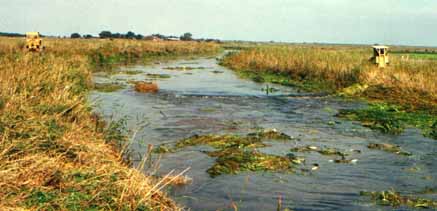
Marine Life Society of South Australia Inc.
Newsletter
February 2005
No. 318"understanding, enjoying & caring for our oceans"
Next Meeting
This will be held at the Conservation Centre, 120 Wakefield Street, Adelaide on Wednesday 16th February commencing at 7.30pm.
Our speaker will be Cara Miller who will be presenting some of her research work on dolphins.
Contents
Dredging of Eight Mile Creek (Part 2)(Neville Skinner)
British Marine Life Study Society (Dr Gerald Legg)
The State Of The Hobart Two Years After
Being Scuttled (Steve Reynolds)
This Newsletter
The hardcopy of the Newsletter is in black and white as usual. A colour version is posted on our website.
A better way of obtaining a colour copy is to receive a PDF version from me on the first of the month (or as close to it as possible.) This you can print off for your records.
Please let me know if you want your name added to my PDF email list and thus save MLSSA postage and a little more of the World’s precious resources.
Philip
Dredging of Eight Mile Creek (Part 2)
Author: N. R. Skinner, October 2004
In April 2003, the ‘SE Catchment Water Management Board’ (SECWMB) met at Kingston, where a report, following a study funded by the Limestone Coast Regional Development Board (LCRDB), into harvesting water from Eight Mile Creek for industry was discussed 7. In that report concern was expressed about the ability of the creek to deliver 55,000 Mega litres of water for harvesting in dry years, and the "physical, chemical and biological impact" this could have.
(I wonder if this report was initiated in part by the application for and subsequent installation of a submersible irrigation pump within Eight Mile Creek around that time. That’s right folks, a pump with about a 30cm intake pipe; more than big enough to suck the small native fish in and expel them as fertiliser across the paddocks!)
In this meeting it was resolved to write to the South East Water Conservation and Drainage Board (SEWCDB) asking that "no further applications for approvals for the taking and diversion of surface water be granted", and to recommend an investigation be conducted into possible unauthorised water taking activities in the coastal zone. I congratulate SECWMB for their decision.
Not only is Eight Mile Creek renown as a biodiversity ‘hotspot’ for native fish, but also for its profusion of submerged aquatic plants that provide faunal refuge (shelter) for the fish from flow and predators.
The South-Eastern Water Conservation and Drainage Board, with approval from the Government, still continue the practice of dredging Eight Mile Creek, despite this creek being the most significant freshwater creek in the South-East, possibly in Australia, as I know of no other creek of such diversity and beauty, which is visited by so many divers and tourists including many overseas visitors.
I had the opportunity on 12-13th May this year to witness this devastation first-hand for myself, along with members of DEAH, the EPA and Native Fish Australia who were contracted to write a report on the impact the dredging might be having on this environment.

Photo: Dredging (N.Skinner)
Try to imagine two Caterpillar tractors, one on each bank of the creek, pulling between them a large steel cable about 20-25mm in diameter, to which is connected a dredge-shaped drag made from large steel girders approx. 10ft x 10ft and possibly weighing as much as two tonnes. Try to imagine these tractors pulling that dredge up and down the creek for two days, at a speed of about 4-5 kph, under a 20-30cm high wave of water.
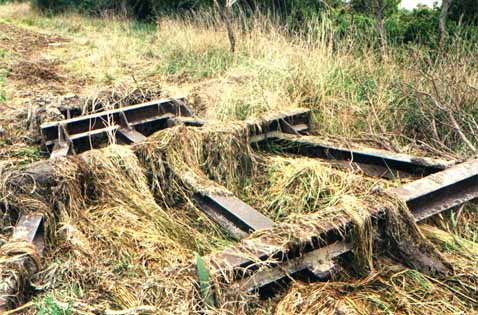
Photo: The dredge that is pulled through the creek (N.Skinner)
And try to imagine the devastation as the unique aquatic vegetation containing the threatened and protected Pygmy Perch is carried out to sea, and then washed back onto the beaches by the tide, so that almost a kilometre long strip of beach is covered in rotting native aquatic vegetation.
Try to imagine the Herons, Pelicans and Turns, along with 600 or so Seagulls, as they fight for a feed of our endangered freshwater fish.
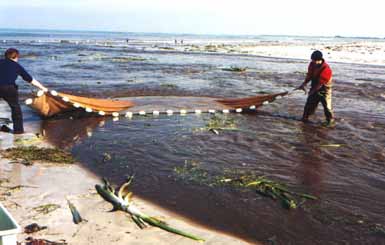
Photo: Survey of native fish being washed out to sea (N.Skinner)
It would be hard to imagine not being sent to gaol or suffering a severe financial penalty if you or I did that!
This method is currently employed to devoid the lower 1.2km section of Eight Mile Creek of its vegetation, which totally devastates that section of the creek from the Spencers Pond (man-made) outlet to the bridge adjacent to the mouth of Eight Mile Creek. And up until about 2001, Eight Mile Creek was dragged all the way from the boundary of Ewens Ponds Conservation Park.
This is a practice of the past that was acceptable in the day when the land was being cleared of anything resembling trees and scrub. Why is it that this practice is still allowed long after land clearing has been legislated against?
And there is yet another very serious impact not so obvious initially, that appears shortly after dredging and remains for several months after the dredging has occurred…
After the water level has dropped in the Creek, combined with the winter rains, the drains start to flow faster into the system, drawing nutrients and/or salt into the pure freshwater of the system. The result is startling – the native aquatic vegetation starts to die as though poisoned through the use of herbicides, and as it dies it forms a brown mucous that coats the sides and bottom of Drain #5 and Eight Mile Creek.
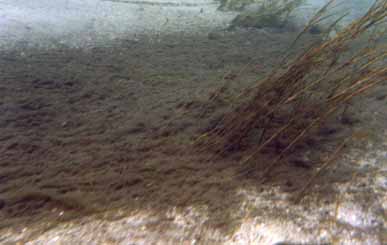
Photo: Eight Mile Creek below surface after dredging (N.Skinner)
Nearby, a small lesser-known pond called Spencers Pond, has been physically isolated from interference through the use of fencing and a sign that bears the words "Scuba Diving and Snorkelling Strictly Prohibited". When the drains were originally constructed, one was routed into Spencers Pond so that it could drain out the other side and then on into Eight Mile Creek. This seems okay, that is, until after Eight Mile Creek has been dredged, allowing the level of Spencers Pond to drop significantly, encouraging the drains to start flowing. Within a couple of months I witnessed the decimation of this natural environment when last August I saw that the aquatic vegetation in this Pond, which was otherwise untouched, had rotted and was falling apart. At least 30-50% of all aquatic vegetation in this Pond was in the latter stages of decay, along with all aquatic vegetation in Drain #5 that feeds into Eight Mile Creek.
I realised then that it was this alga and mucous that we had first observed the previous year and thought was run-off from stormwater drains! What had been a clear pristine pool, full of healthy aquatic vegetation before dredging, had now become a rotting pool of filth.
It is not known at this stage whether this is from the high level of nutrients caused by 12 months of cattle deposits washing off the surrounding farmland, or whether it is from the salt deposits left after the evaporation of irrigation water following the previous summer, but either way, the drainage system is killing this environment.
On the matter of Spencers Pond, I have received a verbal commitment from the SEWCDB to re-route the offending drain around the Pond. This is great news for which I thank the Drainage Board; since I believe this alone will have a very positive affect on the recovery of Eight Mile Creek.
The draft Management Plan of the South-Eastern Water Conservation and Drainage Board 2003-2006, listed amongst its ‘Statutory Functions and Obligations’ (South Eastern Water Conservation and Drainage Act 1992), "The enhancement or development of natural wetlands and the natural environment generally in the South East".
I believe the South Eastern Water Conservation and Drainage Board should receive our every encouragement in this endeavour. Surely it must be possible to drain the adjacent land through means that do not interfere with this natural environment.
I am not suggesting the farmers not have their land drained; what I am saying is there are other ways to do this without directly impacting on the environment as is the case at Eight Mile Creek.
One possible solution that has been discussed with the South-Eastern Water Conservation and Drainage Board is the use of separate drains to drain the land, so that Eight Mile Creek does not have the nutrients pushed into it as is happening at present. Of course this will be costly and requires much planning and earthworks before implementation takes affect.
Another possible and simpler solution, that may or may not work, is to remove the silt from the bed of the lower section of Eight Mile Creek, which is currently being moved back and forth during the existing dragging operations.
I have spoken with representatives of the South Eastern Water Conservation and Drainage Board, and have been informed that "the Eight Mile Creek Advisory Committee will be considering this issue at their next meeting probably in December".
I am cautiously optimistic a motion will be approved to discontinue the practice of dredging Eight Mile Creek of its aquatic vegetation, and that next year alternative means will be made to open a permanent channel down the centre of Eight Mile Creek. This could be done using a long-reach bucket to carefully remove the build up of sediment from within the centre section of Eight Mile Creek from Drain #5 to the sea. It is hoped this removal of silt from the centre of the creek will prevent the regrowth of aquatic vegetation down the centre of the creek, thus maintaining good natural current flow without annual intervention.
Should this fail, I believe new drains will have to be constructed that do not drain into Eight Mile Creek, but rather join Eight Mile Creek at the point near where it runs into the sea.
I have received a promise that the drains into Spencers Pond will be re-routed and I applaud the Drainage Board for this decision.
I am hopeful that by the time you read this the decision to stop dredging Eight Mile Creek will also have been made, and Eight Mile Creek will be on it’s way to recovery, to become South Australia’s premier snorkelling experience, to be enjoyed by all for it’s entire length.
Otherwise, there will be a need to write to the SA Minister for the Environment and the Federal Minister for the Environment to demand legislation be introduced to outlaw this type of practice, anywhere in Australia, and to protect what we have left of our environment while we are able.
For more information contact Neville Skinner at
Neville.Skinner@Gmail.com
REFERENCES:
British Marine Life Study Society
http://www.glaucus.org.uk/Homepage.html
30 October 2004
A Whiting was caught on rod and line four miles out of Brighton, Sussex, and it promptly regurgitated a Seahorse, Hippocampus sp. Seahorses are not known off the Sussex coasts, although I have received at least one unconfirmed sighting before. This is probably the Short-snouted Seahorse, Hippocampus hippocampus. (It is usually the shallow water species Hippocampus guttulatus that has been recorded off the Dorset coast.)
Report by Dr Gerald Legg (Booth Museum) from Jan Light (Conchological Society)
Dr Gerald Legg mailto:Gerald.Legg@brighton-hove.gov.uk
(Booth Museum) http://www.booth.virtualmuseum.info/
Jan Light mailto:jan@aquamar.demon.co.uk
(Conchological Society) http://www.conchsoc.org/2index.htm
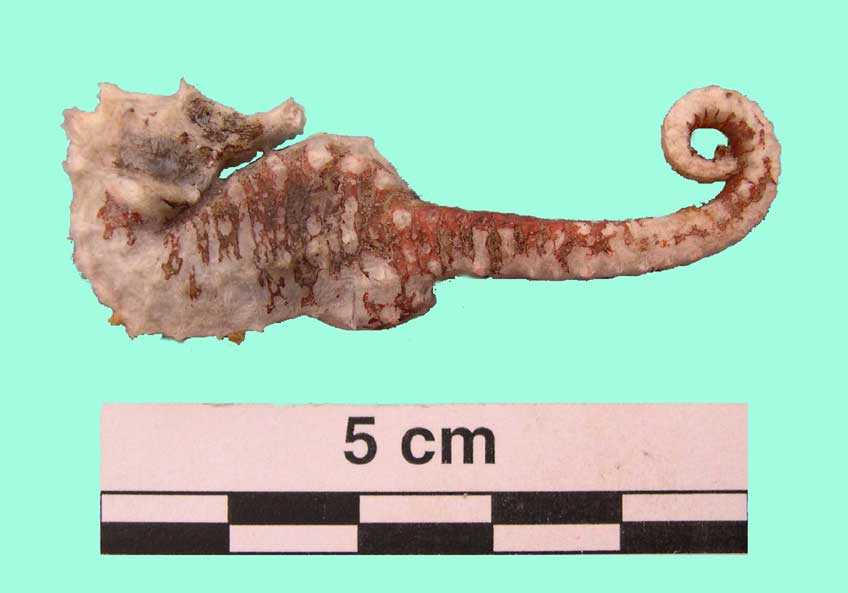
The State Of The Hobart Two Years After Being Scuttled
by Steve Reynolds
On Saturday 30th October Dennis Hutson took me out in his boat for my second dive on the Hobart. My first dive there had been done from Dennis’s boat on 26th April 2003 when the Hobart had only been down for some 5 months.
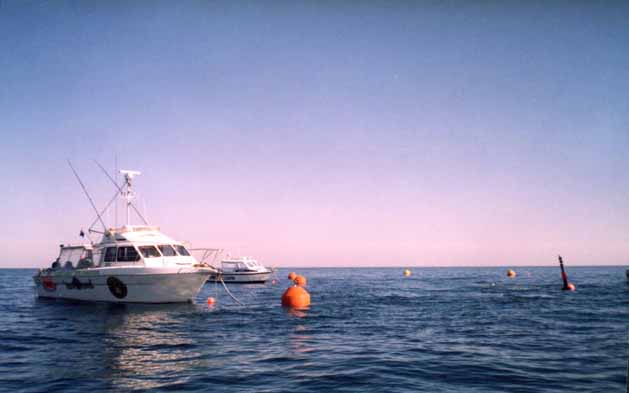
Steve’s photo of the Hobart site on 26th April 2003
Back then Dennis dived with Geoff Prince first. When they returned to the boat I dived with my buddy Peter Gower. We descended the mooring buoy at the bow of the Hobart from where we were able to explore the first third of the ship, just past the bridge and some of the higher superstructure. We had managed to see the keel at 30m, the deck of the bow, the forward gun barrel, the inside of the bridge and the ever-popular toilets. It was, however, soon time for us to start working our way back to the bow area for our return ascent back to Dennis’s boat. The Hobart was very ‘clean’ back then with, as far as we can remember, not much growth on her, if any at all.
On this second dive, some 18 months later, Peter Gower couldn’t come with us so I dived with Dennis this time whilst Geoff dived with Judith Rushton. Judith had attended our clean-up dive at Port Hughes jetty in March 2003. Geoff and Judith did the first leg whilst Dennis and I did the second leg. This time we descended the navigation buoy onto a high point on the Hobart. We had to contend with a stiff current for the whole of the dive. My immediate impression as we approached the Hobart from the navigation buoy was that there was now a lot of growth on her. She had been down for some 103 weeks now (one week short of two years). We were able to enter the engine room where Dennis took some photos with his housed digital camera.
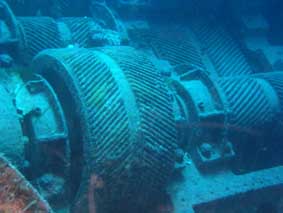
Dennis’s photo of the Hobart’s engine room
As we descended down to the keel of the Hobart on the seabed, I noticed one or two young Snapper swimming around her. I also managed to disturb a good-sized Long-snouted Boarfish which seemed to have settled in a small hole on the side of the hull. Down on the seabed (29m) at the base of the keel Dennis found a medium-sized Hill’s side-gilled slug, Pleurobranchus hilli. It was down there at the keel that Dennis noticed that the thick growth on the side of the hull came to a sudden halt a couple of metres from the seabed. He took some photos of the clear line formed by the end of the thick growth and the ‘clean’ hull.
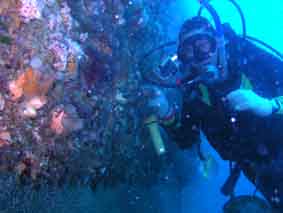
Dennis’s photo of Steve inspecting the
‘clean’ hull below the line of thick growth
It was soon time for us to return to the navigation buoy for our return to the surface. We were struggling against the strong current and we were grateful for the mermaid line thrown to us by Geoff. I later asked Dennis about the sudden halt of the thick growth on the side of the Hobart’s hull. He explained that the ‘clean’ part of the hull had been treated with anti-foulant and nothing would grow there. We thought that it was interesting that the area was so clean after almost two years on the seabed. It will be interesting again to see how long it takes for growth to start appearing in that area. Some of the thick growth on the Hobart is easily broken or damaged by divers i.e. tangled tubeworms by yours truly. I also noticed that some parts of the ship easily crumbled at my touch so the Hobart is now starting to fall apart a bit.